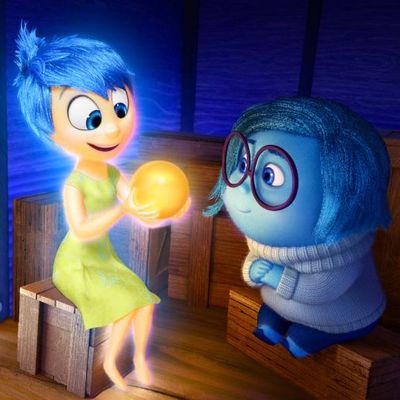
PixarÔÇÖs new film Inside Out follows five anthropomorphized emotions as they vie for control of an 11-year-old girlÔÇÖs mind, and it seems apropos that the two emotions we get to know the best are Joy (voiced by Amy Poehler) and Sadness (played by The OfficeÔÇÖs Phyllis Smith). Certainly, the last two decades of Pixar movies have brought audiences and critics plenty of joy, and to judge from Inside OutÔÇÖs rapturously received Cannes Film Festival bow this morning ÔÇö which led VarietyÔÇÖs Peter Debruge to call PixarÔÇÖs 15th film ÔÇ£one of those rare movies that transcends the mediumÔÇØ ÔÇö there will be plenty of smiles this summer when Inside Out comes out Stateside.
But sadness is an integral part of the Pixar formula, too. Think of Toy Story 3ÔÇÖs tearful finale, or Toy Story 2ÔÇÖs gut-punching Sarah MacLachlan number. Audiences famously wept during the first ten minutes of Up, and when I saw Wall-E again last month (on a bar television with the sound muted, no less), I got watery three times before the first act had even finished. In the same way that older audiences used to cite the death of BambiÔÇÖs mother as an emotional childhood memory and reference point, it seems clear now that for kids today, PixarÔÇÖs oeuvre will provide the same function: TheyÔÇÖre the movies that help children understand that sadness is a part of life.
Ingeniously, thatÔÇÖs the actual theme of Inside Out, though it takes a while to reveal itself. When we first meet the emotions hanging out in the head of young Riley, itÔÇÖs clear that Joy reigns supreme. Every so often, Fear (Bill Hader), Disgust (Mindy Kaling), or Anger (Lewis Black) might take a turn at the console that powers RileyÔÇÖs emotional mood, but they all want whatÔÇÖs best for the girl, and JoyÔÇÖs unbeatable when it comes to producing great memories (which accumulate in RileyÔÇÖs mind as little marbles, each memory ball tinged with the color of the emotion who engineered it). The problem is that as Riley gets older ÔÇö and especially after a move from Minnesota to San Francisco shakes up her family ÔÇö sheÔÇÖs starting to find herself in stressful situations that Joy is powerless to solve. Maybe what this preteen needs is the sort of good cry that Sadness can steer her toward, the sort of wail that strengthens you afterwards because you know youÔÇÖve come out the other side okay.
As I listened to the woman next to me sniffle at todayÔÇÖs screening, I imagined the little Sadness figure in her head, popping forward every so often to press her emotional buttons in the manner Pixar intended. I teared up twice myself, and at unexpected times. The moment that got me the most was a small one, when it looks like a section of RileyÔÇÖs mind ÔÇö an amusement park called Goofball Island ÔÇö will crumble to the ground, taking the girlÔÇÖs silly-funny personality traits with it. I thought of my young niece, and the faces she likes to make to earn a laugh. As she gets older and more self-aware, her Goofball Island will likely be demolished, too, and while it will no doubt be replaced by something new and wonderful ÔÇö just as RileyÔÇÖs mind will be repaired, if Joy has her way ÔÇö the movie reminded me how there are parts of us that are simply lost as we age. They wonÔÇÖt be rebuilt, but paved over. ThatÔÇÖs just how life is.
God, IÔÇÖm crying again just writing this! At least IÔÇÖve got company: At the filmÔÇÖs press conference this afternoon, Kaling said she was teary from the get-go when Pixar wooed her to do a voice in Inside Out. ÔÇ£IÔÇÖm not asked to do that many [movies],ÔÇØ she said. ÔÇ£I have a very specific way that I look and talk and what IÔÇÖm interested in, so IÔÇÖve resigned myself [to it and] know that IÔÇÖm gonna be writing my own work, which is fine for me.ÔÇØ When director Pete Docter flew Kaling up to Northern California to pitch her on the film, then, it was both a welcome validation and an opportunity to open the waterworks. ÔÇ£They showed me the story,ÔÇØ Kaling said, ÔÇ£and I started weeping.ÔÇØ
Kaling also praised Docter and his co-director Ronaldo Del Carmen for the attention they paid to a unique female protagonist. ÔÇ£It gave voice to a demographic that is not often given voice to,ÔÇØ said Kaling. ÔÇ£I remember being an 11-year-old girl, and I didnÔÇÖt have the vocabulary to express how I was feeling. For two men to think it was important to give voice to that ÔÇö and to have girls go and watch it ÔÇö was very moving to me.ÔÇØ It likely will be to audiences, too. Another journalist confessed to me that since sheÔÇÖs seen it, sheÔÇÖs started monitoring her own mood swings, wondering which emotion might be tampering with her console. IÔÇÖve been thinking more about those memory marbles. By the end of Inside Out, Docter and Del Carmen have suggested that JoyÔÇÖs most treasured yellow marbles ÔÇö the core memories of each sublime happiness Riley has experienced in her life ÔÇö may actually need a dash of blue from Sadness. WhatÔÇÖs the right mixture of happiness and melancholy? Ask the wizards at Pixar; theyÔÇÖve figured out the formula.

